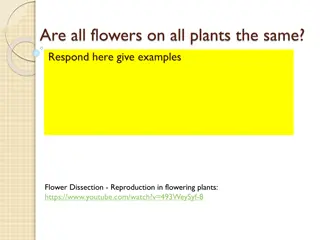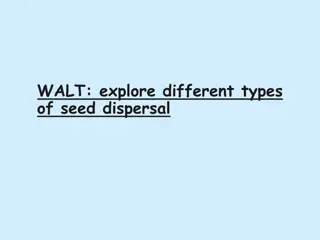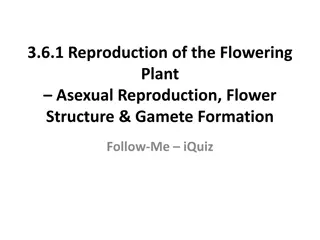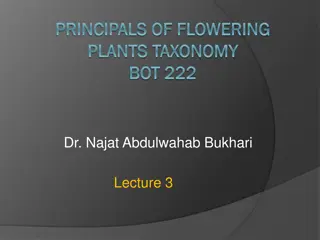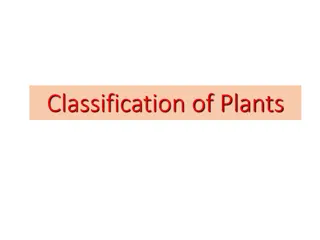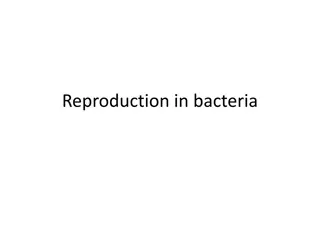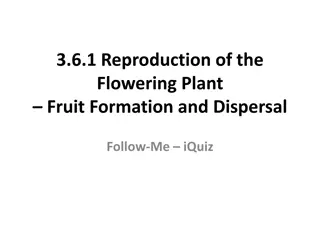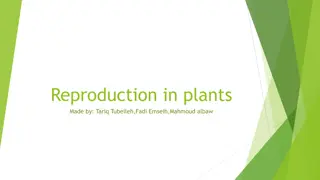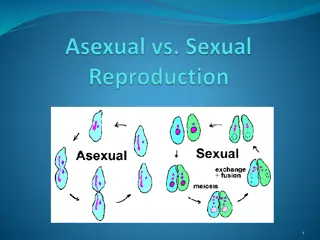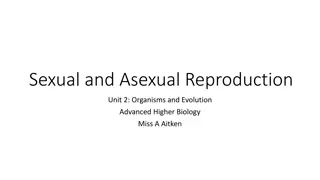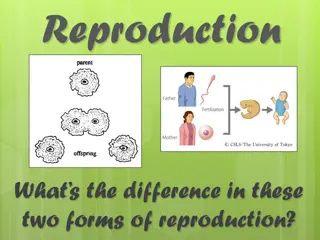Understanding Sexual Reproduction in Flowering Plants
Explore the fascinating process of sexual reproduction in flowering plants, presented by Mr. Rajeshkukar, Principal of Kendriya Vidyalaya No. 1 Devlali. Discover the parts of a flower, including the androecium and gynoecium, stamen, anther structure, and microsporogenesis. Dive into the intricate details of how microspores develop into pollen grains through meiosis, leading to the essential process of pollination. Gain insights into the essential components and mechanisms that drive the reproductive cycle of flowering plants.
Download Presentation

Please find below an Image/Link to download the presentation.
The content on the website is provided AS IS for your information and personal use only. It may not be sold, licensed, or shared on other websites without obtaining consent from the author. Download presentation by click this link. If you encounter any issues during the download, it is possible that the publisher has removed the file from their server.
E N D
Presentation Transcript
SEXUAL REPRODUCTION IN FLOWERING PLANTS Presented by: Mr.Rajeshkukar Principal Kendriya Vidyalaya No.1 Devlali
FLOWER Modified shoot Develops from floral primordia Primordia develop first into floral bud and then into a flower. Reproductive part of plant Androecium is male reproductive whorl, consists of stamens. Gynoecium is female reproductive part of flower, consists of carpel(S).
Stamen Male reproductive unit. Consists of two parts- fillament and anther Fillament is attached to thalamus or petal.
Structure Of Anther (Microsporangium) Bilobed and dithecus. A longitudinal groove separate the theca. In a cross- section anther is a tetragonal structure, consisting of 4 microsporangia, two in each lobes. Later two microsporangia of each lobe fuse as a pollen sac.
Structure Of Anther A microsporangium is circular and surrounded by 4 layers. These are epidermis, endothecium, middle layers tapetum. Outermost layers protect the pollen and help in dehiscence of anther to release pollen.
Structure Of Anther Tapetum nourishes he developing pollen grains. When the anther is young a group of compactly arranged homogenous cells called sporogenous tissue occupies the centre of each microsporangium.
Microsporogenesis The process of formation of microspores from a pollen mother cell through meiosis is called microsporogenesis. The cells of sporogenous tissue undergo meiosis to form microspore tetrad arranged in a cluster of 4 cells.. As each cell of sporogenous tissue has potential to form tetrad, so each cell is a microspore mother cell (PMC). On maturation and dehydration of anther, the spores dissociate and develop into pollen grains. Pollen grains release with the dehiscence of anther.
Pollen Grain (Male Gametophyte) Spherical in shape. Have two layered wall- outer hard exine layer and inner thin intine. Exine- made up of sporopolenin. Resistant to organic matter, withstand high temperature, acids, alkalis and enzymes. It has prominent apertures called germ pores, where sporopolenin is absent. Intine- It is thin, continuous layer, made of cellulose and pectin.
Pollen Grain (Male Gametophyte) Pollen grain cytoplasm is surrounded by plasma membrane. Mature pollen grain has 2 cells- (i) vegetative cell (ii) generative cell. Vegetative cell- bigger, abundant food reserve, large irregular nucleus. Generative cell- small, spindle shaped with dense cytoplasm and a nucleus, floats in vegetative cell cytoplasm. In 60% species pollen grains are shed in 2 celled stage where as 40% species shed in 3 celled stage in which generative cell divides mitotically into 2 male gametes.
Female Reproductive Unit- Pistil Pistil- female reproductive part of flower. It may be mono or bi or tri or polycarpellary, syncarpous or apocarpous. Each pistil consists of ovary, style and stigma. The ovary has one or more cavities called locules. Placenta in locules bears ovules. Number of ovules may be one or more.
Ovule Arises as primordium on placenta. The short stalk which attach ovule with placenta is funicle. The primordium grows into a mass of cells forming nucellus, the body of ovule. The two protective covering of nucellus is integuments, except at the tip leaving a small opening called Micropyle.
Ovule Basal part of ovule is called chalaza that lie opposite to micropyle. Cells of nucellus are rich in reserve food. A single embryo sac or female gametophyte located in the nucellus, which is developed from megaspore.
Megasporogenesis And Development Of Female Gametophyte One of the nucellar cell in the micropylar region is differentiated into megaspore mother cell. The cell is larger, contains dense cytoplasm and a prominent nucleus. It undergoes meiosis forming 4 haploid cells called megaspore tetrad. 3 megaspores degenerate and only one megaspore become functional.
Megasporogenesis And Development Of Female Gametophyte Functional megaspore is the first cell of female gametophyte. Its nucleus undergoes mitosis and the two nuclei move to opposite poles and form 2 nucleate embryo sac. Two successive mitotic division in each of these 2 nuclei form an 8 nucleate embryo sac.
Devices For Autogamy Simultaneous maturation of anther and pistil. Anther and stigma lie close to each other. Cleistogamous flower (oxalis, commelina,viola)
Devices For Xenogamy Unisexual flower and diocious plants. Pollen release and stigma receptivity are not synchronised. Different orientation of anther and stigma of flower. Self incompability.
Adaptation Of Wind Pollinated Flowers Pollen grains are light, nonsticky/ dry, sometimes winged. Well exposed anther. Large feathery stigma. Flowers arranged as inflorescence. Single ovules.
Adaptation Of Water Pollinated Flowers Seen in submerged flowers like Vallisneria and Hydrilla and Zostera. In Vallisneria male flowers released on water surface and female flowers reaches the surface for pollination. In sea grasses, pollen grains are long ribbon like and carried passively to submerged female flowers. Mucilage coated pollen grains.
Adaptation In Insect Pollinated Flowers Large Brightly coloured and showy. If flowers are small, grouped into inflorescence. Highly fragrant Produce nectar Sticky pollen and stigmatic surface Provide rewards to animal pollinator such as nectar, food (pollen) or provide safe place for laying eggs.
Pollen-pistil Interaction Recognition of compatible pollen-It is the interaction between chemical components of pollen and those of stigma. Germination of pollen and development of male gametophyte- (a) compatible pollen starts its germination, stimulated by certain secretion of stigma. (b) intine grows out through one of germ pore. (c) content of pollen moves into the tube i.e. vegetative and generative / 2 male gametes.
Pollen-pistil Interaction (d) pollen tube grows through the tissues of stigma and style by secreting enzymes to digest them and enters ovule through micropyle. (e)It enters the embryo sac through filliform apparatus of one synergids to liberate male gametes. (f) germinated pollen grain with pollen tube carrying vegetative nucleus and 2 male gametes is the fully developed female gametophyte.
Double Fertilisation Release of 2 male gametes from pollen tube into cytoplasm of synergids. Fusion of one male gamete with egg cell called Syngamy and form zygote(2n) which develops into embryo. Fusion of 2nd male gamete with polar nuclei of central cell to form PEN(3n). As syngamy and triple fusion occur in an embryo sac, the phenomenon is known as double fertilisation. Central cell with PEN is called PEC which develops into endosperm.
Post Fertilisation Events Development of endosperm Development of embryo Maturation of ovule into seed Maturation of ovary into fruit.
Endosperm Its development precedes embryo development. There are 3 methods of embryo development : nuclear, cellular, helobial. In nuclear type PEN divides mitotically without cytokinesis and endosperm is free nuclear, then cell wall formation starts from periphery and endosperm become nuclear. It provides food to developing embryo. If endosperm is completely utilised by embryo, seed is non-albuminous, if present ,seed is albuminous.
Embryo It starts after certain embryo formation. Zygote divides mitotically and form proembryo. Then it develops into globular and heart shaped embryo and then horse shoe shaped mature embryo with one or two cotyledon.
Special Reproduction (Apomixis / Agamospory) Seeds are formed without fertilisation. It may develop if a diploid egg cell develops into embryo without fertilisation. If cells of nucellus may develop into embryo and pushed into the embryo.
Special Reproduction (Polyembryony) If more than one egg may form in embryo sac. If more than one embryo sac formed in an ovule. Other cells like synergids or nucellus develop into embryo. E.g. orange, lemon, mango, onion, groundnut etc.



